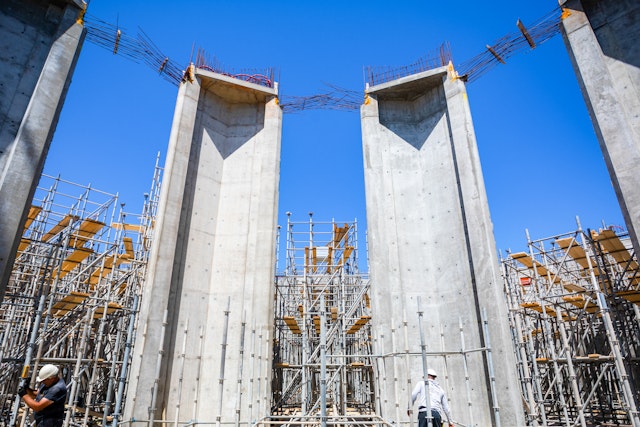The recently completed pillars of the main edifice of the Shrine of ‘Abdu’l-Bahá resonate with profound significance within the context of Bahá’í teachings. These pillars, not merely structural in nature, embody metaphorical representations that reflect the spiritual and ethical tenets esteemed within the Bahá’í Faith. This monumental achievement stands as a symbol of the gathering of collective spiritual strength, unity, and the realization of divine purpose, which are core themes in Bahá’í doctrine.
At the fulcrum of Bahá’í philosophy lies the concept of unity—unity of mankind, unity in diversity, and the unity between the manifest and the unseen. The pillars of the Shrine are emblematic of this ethos. Architecturally, they provide the necessary support and stability needed for the structure, yet they also serve as metaphors for the foundational virtues that uphold society. These virtues include justice, love, compassion, and forgiveness. Each pillar can reasoned to symbolize a distinctive quality, revealing the level of interconnectedness necessary to cultivate a cohesive and harmonious world.
The very act of completion highlights the notion of progress—progress that transcends the physical zenith of construction to touch the spiritual realms of understanding and enlightenment. In Bahá’í teachings, progress is not merely a linear pathway, but rather a circular progression that encompasses learning from the past and innovating for the future. The pillars, therefore, illustrate the importance of building upon the wisdom of previous generations while striving towards the pristine ideals set forth by Bahá’u’lláh. In such a manner, they stand as steadfast reminders of the lessons learned from history, promoting informed choices for sustainable development and community cohesion.
Moreover, the aesthetic nature of the pillars invites contemplation—foreshadowing the grandeur and transcendence of moral aspiration. They rise towards the heavens, symbolic of humanity’s innate yearning to reach for the divine. This aspiration is embedded within the Bahá’í claim that every individual possesses an inherent capacity for greatness, waiting to be nurtured and unleashed. The completed pillars beckon admirers to revitalize their spiritual endeavors, encouraging a lifelong journey of self-improvement and community service, much like the fluid motion between earthbound existence and celestial ideals.
The completion of these pillars also emphasizes the collective endeavor inherent in Bahá’í practice. The visitations and efforts that culminate in such a lasting structure illustrate the way in which collaboration propels a community toward higher aspirations. The participants—from architects to laborers—reflect the unity of purpose that is deeply rooted in Bahá’í teachings. Such collaborative efforts engender a spirit of teamwork, where individual contributions converge into a singular expression of shared vision, embodying the Bahá’í principle that “the best beloved of all things in My sight is justice.”
The shrine itself, with its newly erected pillars, symbolizes the ever-expanding vision of the Bahá’í community. As the edifice takes shape, it serves as a focal point for those who seek refuge in spiritual contemplation. The architecture invites individuals to stand in awe at the intersection of beauty and sanctity, inspiring reflection on one’s responsibility to contribute positively to the world. This is part of the specific calling as delineated in Bahá’í aspirations—every soul should endeavor to build, not only edifices but also societies that resonate with the rhythm of justice, equity, and compassion.
Furthermore, the inscription of sacred writings adorning the structure beckons the viewer to delve into the profound depths of reason, faith, and spirituality. This amalgamation of art, architecture, and enlightenment engenders a collective consciousness that seeks to bridge the human experience with the divine. In this way, the pillars are more than physical manifestations; they are conduits, fostering connections among people and their higher purpose. The Shrine serves as a sanctuary where the weary may replenish their spirits, drawing strength from the collective wisdom imparted by the writings and the luminaries of the past.
As one reflects on the completed pillars of the Shrine of ‘Abdu’l-Bahá, it becomes evident that their significance extends far beyond construction debuts. They encapsulate the potency of community, the richness that arises from unity in diversity, and the aspirations that converge in the service of humanity. The Bahá’í teachings advocate for a world where every pillar, constructed from the values of love, justice, and compassion, can collectively support the edifices of human civilization.
In conclusion, the completion of the pillars of the Shrine symbolizes a monumental step not only for the Bahá’í community but for the entire human tapestry. They invite ongoing reflection on the collective journey toward unity and peace. As individuals visit and ponder the pillars, they are encouraged to take personal strides toward embodying the virtues that they represent. In doing so, they not only honor the architectural masterpiece but also embrace the profound teachings of the Bahá’í Faith, contributing to a world increasingly enriched by divine attributes.
